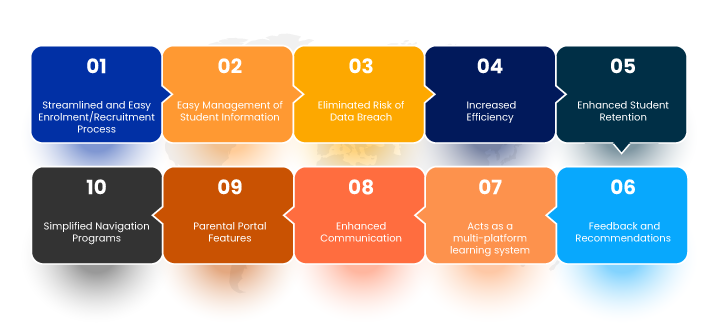

ACL Digital
How do SIS and LMS solutions support the entire student lifecycle?
Technology has brought a revolution in every sector, and every marketplace depends on technologies for effective functioning. The education sector is one such industry that needs to update itself with the new technological advancements to provide students with a better learning experience. E-learning is growing more popular among medium and big enterprises with well-defined educational materials such as presentations, videos, PDFs, etc., that are ready for on-demand learning. One such e-learning approach is the Student information system software that aims at providing
What is a Student Information System?
Student Information System is software that may be implemented by any institution, regardless of its size. Most institutions today prefer an all-in-one solution facilitating functions of both; SIS & LMS. A Student Information System assists in keeping track of all the details about the students in a structured manner. The information includes handling enrolment, queries, student progress tracker, and issuing reminders and notifications. Further, the SIS helps instructors focus on students’ learning and strive for continuous improvement by channeling their workload.
A Learning management system or LMS is a software-based or SaaS platform for managing, automating, and delivering educational courses, training programs, and learning and development programs. The use of a Learning Management Solution is to improve the success and effectiveness of online training to a large range of audiences. There are a plethora of ways a Student Information System and Learning Management system support student lifecycle and some of which are:

1. Streamlined and Easy Enrolment/Recruitment Process
Recruitment of students in an educational institution might be one of the complicated and tiring tasks that require a lot of paperwork. However, the benefit of the Student Management system website can be utilized for hassle-free work. It follows a streamlined process to ensure paperless yet simplified student recruitment and enrolment process availing features such as real-time application tracking among others.
2. Easy Management of Student Information
Student data can be huge, and storing it can be overwhelming, and there are chances it might get misplaced. Further, it can be burdensome and tiring for the administration to manage and handle the registration, information, academic progress, attendance, and other student info. SIS ensures that this can be done with just a mere few clicks, and the data can also be safe and secured. Moreover, you can also go paperless with the SIS, and ultimately, it will also save you time and resources.
3. Eliminated Risk of Data Breach
Educational institutions generally experience pretty common data breaches. However, it is essential to prevent sensitive and confidential data. Institutes must seek more efficient measures to safeguard data than merely filing it in a cabinet. This is where the SIS comes to the rescue since a competent system ensures that the data is secured and managed in a systematic and structured manner. A digitally secured student information system software is preferred for data security. Moreover, the SIS is generally cloud-based, secured, centralized, safe, and thus, the educational institutions can rest assured.
4. Increased Efficiency
LMS provides a structured and managed framework to keep track of the students’ activities and store the grading books or coursing information. The system supports enhancing efficiency by helping in solving any form of grading issues. Furthermore, it also helps organize, analyse and enter data as well as compare them easily.
5. Enhanced Student Retention
With any dropout of students from the university or college, additional funds are generally required to attract the next enrolment to the institution. Cost and credibility become significant concerns if a strong retention strategy is not implemented. The best Learning Management system, which is robust, ensures degree auditing, retention scoring, student attendance, judicial tracking, which ultimately aids in improving student retention.
6. Simplified Navigation Programs
When the navigation is complex and confusing, users will have difficulty finding the required features. It is advised that you use icons, search, sections and subclasses, buttons, and links to make navigating as straightforward as possible. The main intention should be to establish an interface that enables a learner to quickly locate the information they need without going through several pages. Generally, the navigation should be self-explanatory and easy.
7. Parental Portal features
Parents usually want to keep track of their student’s progress. Thus, LMS aims to provide a parental portal for enhanced connections and communications. This feature would enable them to monitor the children’s grades, attendance, and progress in academics and co-curricular activities.
8. Enhanced Communication
The software ensures keeping open communications with the parents and the students. Improved interactions between the teachers and parents assure that students’ grades and progress are kept track of, and a strong teaching-learning community is established. Integrated messaging, alerting notifications, email, texting delivers all types of communication in real-time. Such a framework fosters transparency, which leads to greater institutional efficiency.
9. Acts as a multi-platform learning system
The main goal of creating a learning management system is to allow students to learn whenever, wherever, and on whatever platform they want. Developing a web-based responsive solution that works across many browsers and mobile devices will enable you to deliver online training that meets the demands of your staff and students. The optimization of the platform and content reduces bandwidth consumption.
10. Feedback and Recommendations
Students are the ones who can tell you about their experience with the present education system and give feedback and suggestions. An LMS enables the users to conduct the system usability test to get feedback and recommendations from the students and work on those suggestions to improve the content. You might inquire about their standard and the most pressing requirements.
Conclusion
Online education and learning management solution are crucial in skill development and add significantly. The Student Management System project automates the entire system of an educational institution. Higher education administrators have begun to use the integrated SIS & LMS as a system to improve institutional operations and provide a contemporary, appealing on-campus user experience. This shall save a lot of time and resources for the administration and also provide them with greater efficiency to get their work done. Collaborating with the proper Student Information System provider would provide administrators with real-time data analysis and data insights, allowing them to employ best practices in recruiting, retaining, and developing exemplary teachers and students.
Related Insights


Death to Prompting! Long Live Programming!

The Architecture of Agentic RAG: Reasoning-Driven AI Systems Explained


The AI Developer’s Guide to Data Formats: TOON vs. JSON and Beyond

